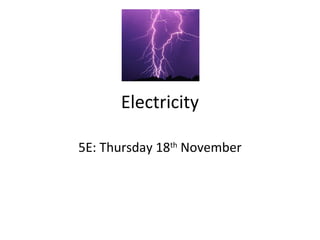
6 d electronics 181110
- 2. Electricity • What is happening in the circuit? • Circuit diagrams • Measuring current
- 3. Model of current flow BakeryBakery SupermarketSupermarket 1. Bakery Manager loads bread onto the vans and sends them off 2. As soon as the vans start to move, bread is delivered to the supermarket. 3. All the vans move at the same speed. 4. If the manager speeds the vans up, more bread is delivered to the supermarket in a certain time. 5. If the manager loads more bread on each van, more bread is delivered to the supermarket in a certain time. The vans deliver the bread to the supermarket where the shoppers take it away. The empty vans go back to the bakery to get more bread. Each van takes bread to the supermarket. Empty vans collect bread at the bakery.
- 4. Model of current flow 1. The battery provides energy and makes the charges move. 2. As soon as the charges start to move, energy is delivered to the bulb 3. All the charges move at the same speed 4. If the charges speed up, more energy is delivered to the bulb in a certain time. 5. If more energy is carried by each charge, more energy is delivered to the bulb in a certain time. Charges deliver energy to the bulb where it is transferred to heat and light. Charges return to the battery to collect more energy. Charges are atom sized particles already in the wire. The charges carry energy. Charges collect energy at the battery. The electric current (Amperes) is the number of charges passing a point each second
- 5. Circuit diagrams • Charges flow in a complete circuit • Components in circuits are drawn using symbols:
- 6. Measuring current • Current (flow of charge) has symbol I, and is measured in Amperes or Amps (A) for short • We use an Ammeter to measure current through a circuit • Ammeter is connected in line with the other components – in series – We ‘break into’ the circuit:
- 7. Measuring current • Current (flow of charge) has symbol I, and is measured in Amperes or Amps (A) for short • We use an Ammeter to measure current through a circuit • Ammeter is connected in line with the other components – in series – We ‘break into’ the circuit:
Editor's Notes
- We can see light and heat given off from a bulb in a simple circuit (cell, switch, lamp) – we can see the effect of the energy transfer – but we cannot see how this happens! What happens in the battery / wires / bulb? To help us understand, we have built a model to explain what is going on. Aim of next few lessons is for you to become experts in understanding and explaining how electric currents work… So let’s talk about something different for a few minutes… Note vans travel nose to tail…. NO VANS DISAPPEAR!!!!
- So looking at the supermarket model and using this to talk about current flow… Current/charge is NOT USED UP in the circuit (i.e. we are NOT ‘using up’ electrons) – only the energy they carried is transferred